Subaru Legacy: *SRS airbag (Supplemental Restraint System airbag)
 Subaru Legacy: *SRS airbag (Supplemental Restraint System airbag)
Subaru Legacy: *SRS airbag (Supplemental Restraint System airbag)
*SRS: This stands for supplemental restraint system. This name is used because the airbag system supplements the vehicle’s seatbelts.
Your vehicle is equipped with a crash sensing and diagnostic module, which will record the use of the seatbelt by the front passenger when any of the SRS frontal, side and curtain airbags deploys.
- Models with SRS airbags and lap/shoulder restraints for driver, front passenger, and window-side rear passengers
- SUBARU advanced frontal airbag system
- SRS side airbag and SRS curtain airbag
- SRS airbag system monitors
- SRS airbag system servicing
- Precautions against vehicle modification
Models with SRS airbags and lap/shoulder restraints for driver, front passenger, and window-side rear passengers
Your vehicle is equipped with a supplemental restraint system in addition to a lap/shoulder belt at each front seating position and each rear window-side seating position. The supplemental restraint system (SRS) consists of six airbags.
The configurations are as follows:
● Driver’s and front passenger’s frontal airbags
● Driver’s and front passenger’s side airbags
● Curtain airbags (for driver, front passenger, and window-side rear passengers)
These SRS airbags are designed only as a supplement to the primary protection provided by the seatbelt.
The system also controls front seatbelt pretensioners. For operation instructions and precautions concerning the seatbelt pretensioner, refer to “Front seatbelt pretensioners” F1-22.
WARNING
● To obtain maximum protection in the event of an accident, the driver and all passengers in the vehicle should always wear seatbelts when the vehicle is moving. The SRS airbag is designed only as a supplement to the primary protection provided by the seatbelt. It does not do away with the need to fasten seatbelts. In combination with the seatbelts, it offers the best combined protection in case of a serious accident. Not wearing a seatbelt increases the chance of severe injury or death in a crash even when the vehicle has the SRS airbag. For instructions and precautions concerning the seatbelt system, refer to “Seatbelts” F1-12.
● Do not sit or lean unnecessarily close to the SRS airbag. Because the SRS airbag deploys with considerable speed – faster than the blink of an eye – and force to protect in high speed collisions, the force of an airbag can injure an occupant whose body is too close to SRS airbag. It is also important to wear your seatbelt to help avoid injuries that can result when the SRS airbag contacts an occupant not in proper position such as one thrown forward during pre-accident braking.
Even when properly positioned, there remains a possibility that an occupant may suffer minor injury such as abrasions and bruises to the face or arms because of the SRS airbag deployment force.
● The SRS airbags deploy with considerable speed and force. Occupants who are out of proper position when the SRS airbag deploys could suffer very serious injuries. Because the SRS airbag needs enough space for deployment, the driver should always sit upright and well back in the seat as far from the steering wheel as practical while still maintaining full vehicle control and the front passenger should move the seat as far back as possible and sit upright and well back in the seat.
● Do not place any objects over or near the SRS airbag cover or between you and the SRS airbag. If the SRS airbag deploys, those objects could interfere with its proper operation and could be propelled inside the vehicle and cause injury.
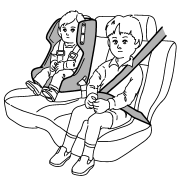
WARNING
● Put children in the rear seat properly restrained at all times. The SRS airbag deploys with considerable speed and force and can injure or even kill children, especially if they are not restrained or improperly restrained. Because children are lighter and weaker than adults, their risk of being injured from deployment is greater. Consequently, we strongly recommend that ALL children (including those in child seats and those that have outgrown child restraint devices) sit in the REAR seat properly restrained at all times in a child restraint device or in a seatbelt, whichever is appropriate for the child’s age, height and weight. Secure ALL types of child restraint devices (including forward facing child seats) in the REAR seats at all times. According to accident statistics, children are safer when properly restrained in the rear seating positions than in the front seating positions.
For instructions and precautions concerning the child restraint system, refer to “Child restraint systems” F1-25.
● NEVER INSTALL A REARWARD FACING CHILD SEAT IN THE FRONT SEAT. DOING SO RISKS SERIOUS INJURY OR DEATH TO THE CHILD BY PLACING THE CHILD’S HEAD TOO CLOSE TO THE SRS AIRBAG.
● Never allow a child to stand up, or to kneel on the front passenger’s seat, or never hold a child on your lap or in your arms. The SRS airbag deploys with considerable force and can injure or even kill the child.
CAUTION
● When the SRS airbag deploys, some smoke will be released. This smoke could cause breathing problems for people with a history of asthma or other breathing trouble. If you or your passengers have breathing problems after SRS airbag deploys, get fresh air promptly.
● A deploying SRS airbag releases hot gas. Occupants could get burned if they come into direct contact with the hot gas.
NOTE
When you sell your vehicle, we urge you to explain to the buyer that it is equipped with SRS airbags by alerting the buyer to the applicable section in this Owner’s Manual.
Components
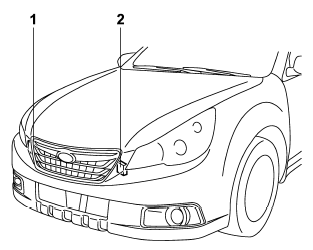
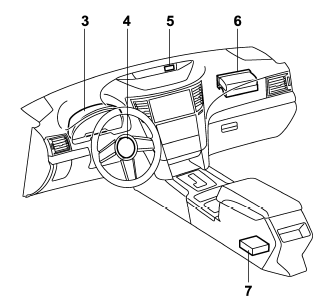
1) Front sub sensor (right-hand side)
2) Front sub sensor (left-hand side)
3) SRS airbag system warning light
4) Frontal airbag module (driver’s side)
5) Front passenger’s frontal airbag ON and OFF indicator
6) Frontal airbag module (front passenger’s side)
7) Airbag control module (including impact sensor [all models] and rollover sensor
[Outback])
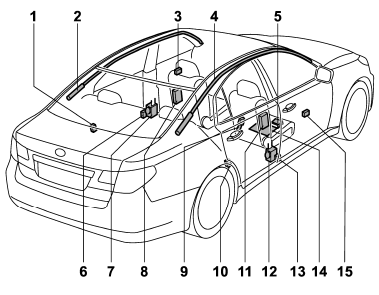
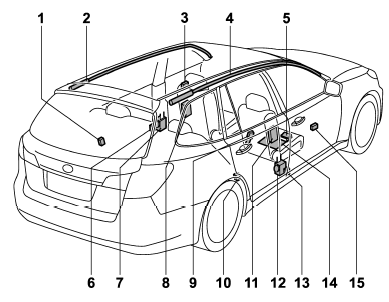
1) Rear wheel house impact sensor (lefthand side)
2) Curtain airbag module (left-hand side)
3) Front door impact sensor (left-hand side)
4) Curtain airbag module (right-hand side)
5) Front passenger’s occupant detection control module
6) Center pillar impact sensor (left-hand side)
7) Seatbelt pretensioner (left-hand side)
8) Side airbag module (left-hand side)
9) Seatbelt buckle switch (right-hand side)
10) Rear wheel house impact sensor (righthand side)
11) Side airbag module (right-hand side)
12) Seatbelt pretensioner (right-hand side)
13) Center pillar impact sensor (right-hand side)
14) Front passenger’s occupant detection system weight sensor
15) Front door impact sensor (right-hand side)
SUBARU advanced frontal airbag system
Your vehicle is equipped with a SUBARU advanced frontal airbag system that complies with the new advanced frontal airbag requirements in the amended Federal Motor Vehicle Safety Standard (FMVSS) No. 208.
The SUBARU advanced frontal airbag system automatically determines the deployment force of the driver’s SRS frontal airbag at the time of deployment as well as whether or not to activate the front passenger’s SRS frontal airbag and, if activated, the deployment force of the SRS frontal airbag at the time of deployment. Your vehicle has warning labels on the driver’s and front passenger’s sun visors beginning with the phrase “EVEN WITH ADVANCED AIR BAGS” and a tag attached to the glove box lid beginning with the phrase “Even with Advanced Air Bags”. Make sure that you carefully read the instructions on the warning labels and tag.
Always wear your seatbelt. The SUBARU advanced frontal airbag system is a supplemental restraint system and must be used in combination with a seatbelt. All occupants should wear a seatbelt or be seated in an appropriate child restraint system.
The driver’s SRS frontal airbag is stowed in the center portion of the steering wheel. The front passenger’s SRS frontal airbag is stowed near the top of the dashboard under an “SRS AIRBAG” mark. In a moderate to severe frontal collision, the driver’s and front passenger’s SRS frontal airbags deploy and supplement the seatbelts by reducing the impact on the driver’s and front passenger’s head and chest.
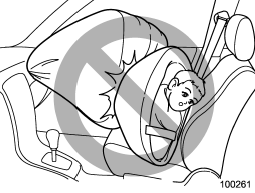
WARNING
NEVER INSTALL A REARWARD FACING CHILD SAFETY SEAT IN THE FRONT SEAT. DOING SO RISKS SERIOUS INJURY OR DEATH TO THE CHILD BY PLACING THE CHILD’S HEAD TOO CLOSE TO THE SRS AIRBAG.
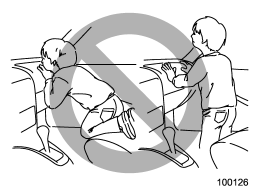
WARNING
Never allow a child to stand up, or to kneel on the front passenger’s seat. The SRS airbag deploys with considerable force and can injure or even kill the child.
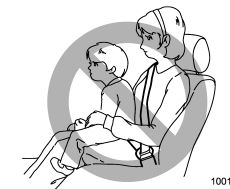
WARNING
Never hold a child on your lap or in your arms. The SRS airbag deploys with considerable force and can injure or even kill the child.
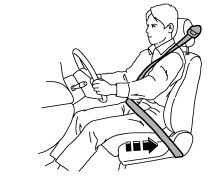
WARNING
The SRS airbag deploys with considerable speed and force. Occupants who are out of proper position when the SRS airbag deploys could suffer very serious injuries. Because the SRS airbag needs enough space for deployment, the driver should always sit upright and well back in the seat as far from the steering wheel as practical while still maintaining full vehicle control and the front passenger should move the seat as far back as possible and sit upright and well back in the seat.
It is also important to wear your seatbelt to help avoid injuries that can result when the SRS airbag contacts an occupant not in proper position such as one thrown toward the front of the vehicle during preaccident braking.
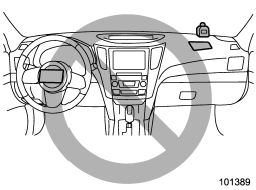
WARNING
Do not put any objects over the steering wheel pad and dashboard. If the SRS frontal airbag deploys, those objects could interfere with its proper operation and could be propelled inside the vehicle and cause injury.
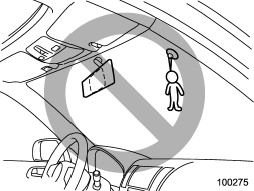
WARNING
Do not attach accessories to the windshield, or fit an extra-wide mirror over the rear view mirror. If the SRS airbag deploys, those objects could become projectiles that could seriously injure vehicle occupants.
Driver’s SRS frontal airbag
The driver’s SRS frontal airbag uses a dual stage inflator. The inflator operates in different ways depending on the severity of impact.
Have the system inspected by your SUBARU dealer immediately if the SRS airbag system warning light illuminates.
NOTE
The driver’s SRS side airbag, SRS curtain airbag and seatbelt pretensioner are not controlled by the SUBARU advanced frontal airbag system.
Front passenger’s SRS frontal airbag
The front passenger’s SRS frontal airbag uses a dual stage inflator. The inflator operates in different ways depending on the severity of impact.
The total load on the seat is monitored by the passenger’s occupant detection system weight sensor under the seat.
Using the total seat load and seatbelt buckle switch, the occupant detection system determines whether the front passenger’s SRS frontal airbag should or should not be inflated.
The occupant detection system may not inflate the front passenger’s SRS frontal airbag even when the driver’s SRS frontal airbag deploys. This is normal.
Observe the following precautions. Failure to do so may prevent the SUBARU advanced frontal airbag system from functioning correctly or cause the system to fail.
● Do not apply any strong impact to the front passenger’s seat such as by kicking.
● Do not spill liquid on the front passenger’s seat. If liquid is spilled, wipe
it off immediately.
● Do not remove or disassemble the front passenger’s seat.
● Do not install any accessory (such as an audio amplifier) other than a genuine
SUBARU accessory under the front passenger’s seat.
● Do not place anything (shoes, umbrella, etc.) under the front passenger’s seat.
● The front passenger’s seat must not be used with the head restraint removed.
● Do not leave any articles on the front passenger’s seat or the seatbelt tongue
and buckle engaged when you leave your vehicle.
● Do not place a magnet near the seatbelt buckle and the seatbelt retractor.
● Do not use front seats with their backward- forward position and seatback not
being locked into place securely. If any of them are not locked securely, adjust
them again. For adjusting procedure, refer to “Manual seat” F1-3 (models equipped
with manual seats only).
If the seatbelt buckle switch and/or front passenger’s occupant detection system
have failed, the SRS airbag system warning light will illuminate. Have the system
inspected by your SUBARU dealer immediately if the SRS airbag system warning light
illuminates.
If your vehicle has sustained impact, this may affect the proper function of the SUBARU advanced frontal airbag system. Have your vehicle inspected at your SUBARU dealer.
NOTE
The front passenger’s SRS side airbag, SRS curtain airbag and seatbelt pretensioner are not controlled by the SUBARU advanced frontal airbag system.
Passenger’s frontal airbag ON and OFF indicators
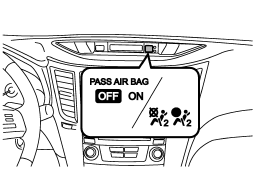

The front passenger’s frontal airbag ON and OFF indicators show you the status of the front passenger’s SRS frontal airbag. The indicators are located next to the clock in the center portion of the dashboard.
When the ignition switch is turned to the “ON” position, both the ON and OFF indicators illuminate for 6 seconds during which time the system is checked. Following the system check, both indicators turn off for 2 seconds. After that, one of the indicators illuminates depending on the status of the front passenger’s SRS frontal airbag determined by the SUBARU advanced frontal airbag system monitoring.
If the front passenger’s SRS frontal airbag is activated, the passenger’s frontal airbag ON indicator will illuminate while the OFF indicator will remain off.
If the front passenger’s SRS frontal airbag is deactivated, the passenger’s frontal airbag ON indicator will remain off while the OFF indicator will illuminate.
With the ignition switch turned to the “ON” position, if both the ON and OFF indicators remain illuminated or off simultaneously even after the system check period, the system is malfunctioning. Contact your SUBARU dealer immediately for an inspection.
Conditions in which front passenger’s SRS frontal airbag is not activated
The front passenger’s SRS frontal airbag will not be activated when any of the following conditions are met regarding the front passenger’s seat:
● The seat is empty.
● The seat is equipped with a rearward facing child restraint system and an infant
is restrained with it. (See WARNING that follows.)
● The seat is equipped with a forward facing child restraint system and a small
child is restrained with it. (See WARNING that follows.)
● The seat is equipped with a booster seat and a small child is in the booster seat.
(See WARNING that follows.)
● The seat is relieved of the occupant load for a time exceeding the predetermined
monitoring time period.
● The seat is occupied by a child who has outgrown a child restraint system (See
WARNING that follows.) or by a small adult.
● The front passenger’s occupant detection system is malfunctioning.
WARNING
NEVER INSTALL A REARWARD FACING CHILD SEAT IN THE FRONT PASSENGER’S SEAT EVEN IF THE FRONT PASSENGER’S SRS FRONTAL AIRBAG IS DEACTIVATED. Be sure to install it in the REAR seat in a correct manner. Also, it is strongly recommended that any forward facing child seat or booster seat be installed in the REAR seat, and that even children who have outgrown a child restraint system be also seated in the REAR seat. This is because children sitting in the front passenger’s seat may be killed or severely injured should the front passenger’s SRS frontal airbag deploy. REAR seats are the safest place for children.
When the front passenger’s seat is occupied by a child, observe the following precautions. Failure to do so may increase the load on the front passenger’s seat, activating the front passenger’s SRS frontal airbag even though that seat is occupied by a child.
● Do not place any article on the seat other than the child occupant and a child
restraint system.
● Do not place more than one child on the seat.
● Do not install any accessory such as a table or TV onto the seatback.
● Do not store a heavy load in the seatback pocket.
● Do not allow the rear seat occupant to place his/her hands or legs on the front
passenger’s seatback, or allow him/her to pull the seatback.
If the front passenger’s frontal airbag ON indicator illuminates and the OFF indicator turns off even when an infant or a small child is in a child restraint system (including booster seat)
Turn the ignition switch to the “LOCK” position if the front passenger’s frontal airbag ON indicator illuminates and the OFF indicator turns off even when an infant or a small child is in a child restraint system (including booster seat). Remove the child restraint system from the seat. By referring to the child restraint manufacturer’s recommendations as well as the child restraint system installation procedures in “Child restraint systems” F1-25, correctly install the child restraint system. Turn the ignition switch to the “ON” position and make sure that the front passenger’s frontal airbag ON indicator turns off and the OFF indicator illuminates. If still the ON indicator remains illuminated while the OFF indicator turns off, take the following actions.
● Ensure that no article is placed on the seat other than the child restraint
system and the child occupant.
● Ensure that there is no article left in the seatback pocket.
● Ensure that the backward-forward position and seatback of front passenger’s seat
are locked into place securely by moving the seat back and forth. (Models equipped
with manual seats only)
If the ON indicator still remains illuminated while the OFF indicator turns off after taking relevant corrective actions described above, relocate the child restraint system to the rear seat and immediately contact your SUBARU dealer for an inspection.
NOTE
When a child who has outgrown a child restraint system or a small adult is seated in the front passenger’s seat, the SUBARU advanced frontal airbag system may or may not activate the front passenger’s SRS frontal airbag depending on the occupant’s seating posture. If the front passenger’s SRS frontal airbag is activated (the ON indicator remains illuminated while the OFF indicator turns off), take the following actions.
● Ensure that no article is placed on the seat other than the occupant.
● Ensure that there is no article left in the seatback pocket.
If the ON indicator still remains illuminated while the OFF indicator turns off despite the fact that the actions noted above have been taken, seat the child/ small adult in the rear seat and immediately contact your SUBARU dealer for an inspection. Even if the system has passed the dealer inspection, it is recommended that on subsequent trips the child/small adult always take the rear seat.
Children who have outgrown a child restraint system should always wear the seatbelt irrespective of whether the airbag is deactivated or activated.
Conditions in which front passenger’s SRS frontal airbag is activated
The front passenger’s SRS frontal airbag will be activated for deployment upon impact when any of the following conditions is met regarding the front passenger’s seat.
● When the seat is occupied by an adult.
● When a heavy article is placed on the seat.
When the front passenger’s seat is occupied by an adult, observe the following precautions. Failure to do so may lessen the load on the front passenger’s seat, deactivating the front passenger’s SRS frontal airbag despite the fact that the seat is occupied by an adult.
● Do not allow the rear seat occupant to lift the front passenger’s seat cushion
using his/her feet.
● Do not place any article under the front passenger’s seat, or squeeze any article
from behind and under the seat. This may lift the seat cushion.
● Do not squeeze any article between the front passenger’s seat and side trim/ pillar,
door or center console box. This may lift the seat cushion.
If the passenger’s frontal airbag OFF indicator illuminates and the ON indicator turns off even when the front passenger’s seat is occupied by an adult
This can be caused by the adult incorrectly sitting in the front passenger’s seat. Turn the ignition switch to the “LOCK” position. Ask the front passenger to set the seatback to the upright position, sit up straight in the center of the seat cushion, correctly fasten the seatbelt, position his/ her legs out forward, and adjust the seat to the rearmost position. Turn the ignition switch to the “ON” position. If the OFF indicator remains illuminated while the ON indicator remains off, take the following actions.
● Turn the ignition switch to the “LOCK” position.
● Ensure that there is no article, book, shoe, or other object trapped under the
seat, at the rear of the seat, or on the side of the seat.
● Ensure that the backward-forward position and seatback of front passenger’s seat
are locked into place securely by moving the seat back and forth. (Models equipped
with manual seats only)
● Next, turn the ignition switch to the “ON” position and wait 6 seconds to allow
the system to complete self-checking. Following the system check, both indicators
turn off for 2 seconds. Now, the ON indicator should illuminate while the OFF indicator
remains off.
If the OFF indicator still remains illuminated while the ON indicator remains off, ask the occupant to move to the rear seat and immediately contact your SUBARU dealer for an inspection.
Effect vehicle modifications made for persons with disabilities may have on SUBARU advanced frontal airbag system operation (U.S. only)
Changing or moving any parts of the front seats, seat belts, front bumper, front side frame, instrument panel, combination meter, steering wheel, steering column, tire, suspension or floor panel can affect the operation of the SUBARU advanced airbag system. If you have any questions, you may contact the following SUBARU distributors:
There are currently no SUBARU distributors in any other U.S. territories. If you are in such an area, please contact the SUBARU distributor or dealer from which you bought your vehicle.
Operation
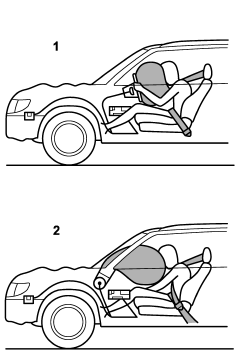
1) Driver’s side
2) Passenger’s side
The SRS airbag can function only when the ignition switch is in the “ON” position. The SUBARU advanced frontal airbag system is designed to determine the activation or deactivation condition of the front passenger’s SRS frontal airbag depending on the total load on the front passenger’s seat monitored by the front passenger’s occupant detection system weight sensor. For this reason, only the driver’s SRS frontal airbag may deploy in the event of a collision, but this does not mean failure of the system.
If the front sub sensors inside both front fenders and the impact sensors in the airbag control module detect a predetermined amount of force during a frontal collision, the control module sends signals to the airbag module(s) (only driver’s module or both driver’s and front passenger’s modules) instructing the module(s) to inflate the SRS frontal airbag(s). The driver’s and front passenger’s SRS frontal airbags use dual stage inflators. The two inflators of each airbag are triggered either sequentially or simultaneously, depending on the severity of impact in the case of the driver’s SRS frontal airbag and depending on the severity of impact and the total load on the seat in the case of the front passenger’s SRS frontal airbag.
After deployment, the SRS airbag immediately starts to deflate so that the driver’s vision is not obstructed. The time required from detecting impact to the deflation of the SRS airbag after deployment is shorter than the blink of an eye.
Both when only the driver’s SRS frontal airbag deploys and the driver’s and front passenger’s SRS frontal airbags deploy, the driver’s and front passenger’s seatbelt pretensioners operate at the same time.
Although it is highly unlikely that the SRS airbag would activate in a non-accident situation, should it occur, the SRS airbag will deflate quickly, not obscuring vision and will not interfere with the driver’s ability to maintain control of the vehicle.
When the SRS airbag deploys, a sudden, fairly loud inflation noise will be heard and some smoke will be released. These occurrences are a normal result of the deployment. This smoke does not indicate a fire in the vehicle.
CAUTION
Do not touch the SRS airbag system components around the steering wheel and dashboard with bare hands right after deployment. Doing so can cause burns because the components can be very hot as a result of deployment.
The driver’s SRS frontal airbag and front passenger’s SRS frontal airbag are designed to deploy in the event of an accident involving a moderate to severe frontal collision. It is basically not designed to deploy in lesser frontal impacts because the necessary protection can be achieved by the seatbelt alone. Also, they are basically not designed to deploy in side or rear impacts or in roll-over accidents because deployment of only the driver’s SRS frontal airbag or both driver’s and front passenger’s SRS frontal airbags would not help the occupant in those situations. The driver’s and front passenger’s SRS frontal airbags are designed to function on a one-time-only basis.
SRS airbag deployment depends on the level of force experienced in the passenger compartment during a collision. That level differs from one type of collision to another, and it may have no bearing on the visible damage done to the vehicle itself.
Examples of accident in which the driver’s/driver’s and front passenger’s SRS frontal airbag(s) will most likely deploy.
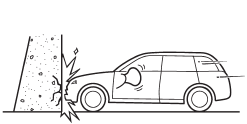
A head-on collision against a thick concrete wall at a vehicle speed of 12 to 19 mph (20 to 30 km/h) or higher activates only the driver’s SRS frontal airbag or both driver’s and front passenger’s SRS frontal airbags. The airbag(s) will also be activated when the vehicle is exposed to a frontal impact similar in fashion and magnitude to the collision described above.
Examples of the types of accidents in which it is possible that the driver’s/driver’s and front passenger’s SRS frontal airbag(s) will deploy.
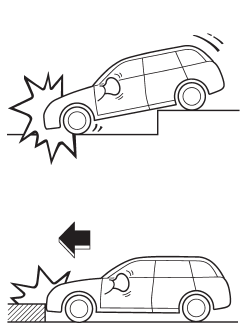
Only the driver’s SRS frontal airbag or both driver’s and front passenger’s SRS frontal airbags may be activated when the vehicle sustains a hard impact in the undercarriage area from the road surface (such as when the vehicle plunges into a deep ditch, is severely impacted or knocked hard against an obstacle on the road such as a curb).
Examples of the types of accidents in which deployment of the driver’s/driver’s and front passenger’s SRS frontal airbag(s) is unlikely to occur.
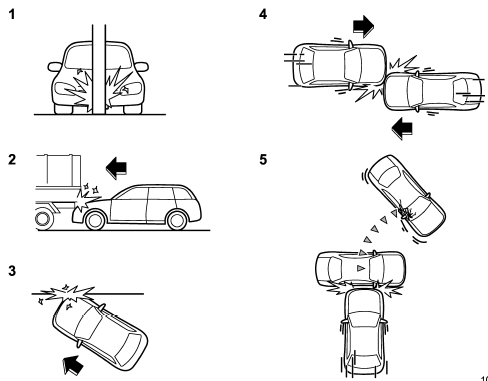
1) The vehicle strikes an object, such as a telephone pole or sign pole.
2) The vehicle slides under the load bed of a truck.
3) The vehicle sustains an oblique offset frontal impact.
4) The vehicle sustains an offset frontal collision.
5) The vehicle strikes an object that can move or deform, such as a parked vehicle.
There are many types of collisions which might not necessarily require deployment of driver’s/driver’s and front passenger’s SRS frontal airbag(s). In the event of accidents like those illustrated, the driver’s/ driver’s and front passenger’s SRS frontal airbag(s) may not deploy depending on the level of accident forces involved.
Examples of the types of accidents in which the driver’s/driver’s and front passenger’s SRS frontal airbag(s) will basically not deploy.
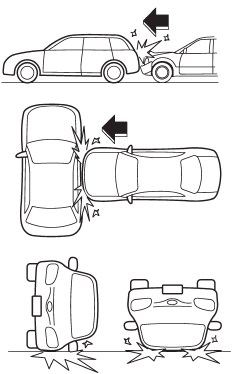
The driver’s and front passenger’s SRS frontal airbags are designed basically not to deploy if the vehicle is struck from the side or from behind, or if it rolls onto its side or roof, or if it is involved in a lowspeed frontal collision.
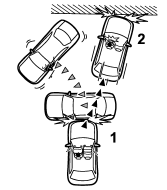
1) First impact
2) Second impact
In an accident where the vehicle is impacted more than once, the driver’s and/or front passenger’s SRS frontal airbag(s) will deploy only once on the first impact.
Example: In the case of a double collision, first with another vehicle, then against a concrete wall in immediate succession, once either or both of the driver’s and front passenger’s SRS frontal airbags is/are activated on the first impact, it/they will not be activated on the second impact.
WARNING
If the vehicle is damaged in an accident but the SRS frontal airbag does not deploy, contact your SUBARU dealer as soon as possible.
SRS side airbag and SRS curtain airbag
The SRS side airbag is stored in the door side of each front seat seatback, which bears an “SRS AIRBAG” label.
In a moderate to severe side impact collision, the SRS side airbag on the impacted side of the vehicle deploys between the occupant and the door panel and supplements the seatbelt by reducing the impact on the occupant’s chest and waist. The SRS side airbag operates only for front seat occupants.
The SRS curtain airbag on each side of the cabin is stored in the roof side (between the front pillar and a point over the rear seat). An “SRS AIRBAG” mark is located at the top of each center pillar. In a moderate to severe side impact collision, the SRS curtain airbag on the impacted side of the vehicle deploys between the occupant and the side window and supplements the seatbelt by reducing the impact on the occupant’s head.
In the event of a rollover, for Outback models, the SRS curtain airbags on both sides of the vehicle deploy between the occupant and the side window and supplement the seatbelt by reducing the impact to the occupant’s head.
WARNING
The SRS side airbag and SRS curtain airbag are designed as only a supplement to the primary protection provided by the seatbelt. They do not do away with the need to fasten seatbelts. It is also important to wear your seatbelt to help avoid injuries that can result when an occupant is not seated in a proper upright position.
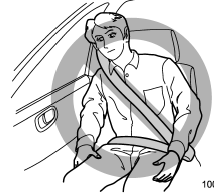
WARNING
● Do not sit or lean unnecessarily close to either front door. The SRS side airbag is stored in both front seat seatbacks next to the door, and it provides protection by deploying rapidly (faster than the blink of an eye) in the event of a side impact collision. However, the force of SRS side airbag deployment may cause injuries if your head or other parts of the body are too close to the SRS side airbag.
● Since your vehicle is equipped with SRS curtain airbags, do not sit or lean unnecessarily close to the front or rear door on either side. Also, do not put your head, arms and hands out of the window. The SRS curtain airbag on each side of the cabin is stored in the roof side (between the front pillar and a point over the rear seat), and it provides protection by deploying rapidly (faster than the blink of an eye) in the event of a side impact. For Outback models, the SRS curtain airbags also deploy in the event of a rollover. However, the force of its deployment may cause injuries if your head is too close to it.
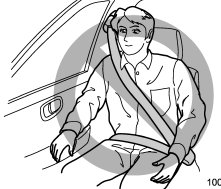
Do not rest your arm on either front door or its internal trim. It could be injured in the event of SRS side airbag deployment.
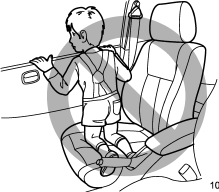
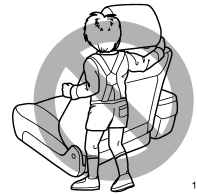
WARNING
● Never allow a child to kneel on the front passenger’s seat facing the side window or wrap his/her arms around the front seat seatback. In the event of an accident, the force of the SRS side airbag deployment could injure the child seriously because his/her head or arms or other parts of the body are too close to the SRS side airbag.
Since your vehicle is also equipped with a front passenger’s SRS frontal airbag, children aged 12 and under should be placed in the rear seat anyway and should be properly restrained at all times.
● Never allow a child to kneel on any passenger’s seat facing the side window or put their head, arms or hands out of the window. In the event of an accident, the force of the SRS curtain airbag deployment could injure the child seriously because his/her head is close to the SRS curtain airbag.
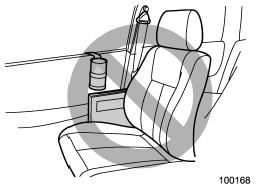
WARNING
● Do not attach accessories to the door trim or near either SRS side airbags and do not place objects near the SRS side airbags. In the event of the SRS side airbag deployment, they could be propelled dangerously toward the vehicle’s occupants and cause injuries.
● Do not attach a hands-free microphone or any other accessory to a front pillar, a center pillar, a rear pillar, the windshield, a side window, an assist grip, or any other cabin surface that would be near a deploying SRS curtain airbag. A hands-free microphone or other accessory in such a location could be propelled through the cabin with great force by the curtain airbag, or it could prevent correct deployment of the curtain airbag. In either case, the result could be serious injuries.
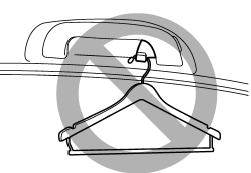
WARNING
Do not hang coat hangers or other hard or pointed objects on the coat hooks. If such items were hanging on the coat hooks during deployment of the SRS curtain airbags, they could cause serious injuries by coming off the coat hooks and being thrown through the cabin or by preventing deployment of the curtain airbags.
Before hanging clothing on the coat hooks, make sure there are no sharp objects in the pockets. Hang clothing directly on the coat hooks without using hangers.
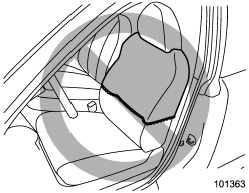
WARNING
Do not put any kind of cover or clothes or other objects over either front seatback and do not attach labels or stickers to the front seat surface on or near the SRS side airbag. They could prevent proper deployment of the SRS side airbag, reducing protection available to the front seat’s occupant.
Operation
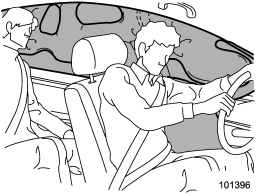
The SRS side airbag and SRS curtain airbag can function only when the ignition switch is in the “ON” position.
The driver’s and front passenger’s SRS side airbags and SRS curtain airbags deploy independently of each other because each has its own impact sensor. Therefore, they may not both deploy in the same accident. Also, the SRS side airbag and SRS curtain airbag deploys independently of the driver’s and front passenger’s SRS frontal airbags in the steering wheel and instrument panel.
An impact sensor, which senses impact force, is located in each of the following locations.
● In the left and right front doors
● In the left and right center pillars
● In the left and right rear wheel houses
● In the airbag control module
For Outback models, a rollover sensor is also located inside the airbag control module.
If the impact sensor that is located in the airbag control module and one of the center pillar impact sensors or front door impact sensors together sense an impact force above a predetermined level in a side collision, the control module causes both the SRS side airbag and curtain airbag on the impacted side to inflate regardless of whether the rear wheel house impact sensor on the same side senses an impact.
If the impact sensor that is located in the airbag control module and one of the rear wheel house impact sensors together sense an impact force above a predetermined level in a side collision, the control module causes only the SRS curtain airbag on the impacted side to inflate. For Outback models, if the rollover sensor detects rollover of the vehicle, the control module inflates the SRS curtain airbags. At this time, the driver’s and front passenger’s seatbelt pretensioners also operate at the same time.
After the deployment, the SRS side airbag immediately starts to deflate. The time required from detection of an impact to deflation of an SRS side airbag after deployment is shorter than the blink of an eye.
The SRS curtain airbag remains inflated for a while following deployment then slowly deflates.
The SRS side airbag and SRS curtain airbag deploy even when no one occupies the seat on the side on which an impact is applied.
When the SRS side airbag and SRS curtain airbag deploy, a sudden, fairly loud inflation noise will be heard and some smoke will be released. These occurrences are a normal result of the deployment. This smoke does not indicate a fire in the vehicle.
CAUTION
Do not touch the SRS side airbag system components around the front seat seatback with bare hands right after deployment. Doing so can cause burns because the components can be very hot as a result of deployment.
After deployment, do not touch any part of the SRS curtain airbag system (from the front pillar to the part of the roof side over the rear seat). Doing so can cause burns because the components can be very hot as a result of deployment.
The SRS side airbag and SRS curtain airbag are designed to deploy in the event of an accident involving a moderate to severe side impact collision. They are basically not designed to deploy in a lesser side impact.
The SRS side airbag and SRS curtain airbag deployment depend on the level of force experienced in the passenger compartment during a side impact collision.
That level differs from one type of collision to another, and it may have no bearing on the visible damage done to the vehicle itself.
For Outback models, the SRS curtain airbags are also designed to deploy when the vehicle is in an extremely inclined state such as during a rollover. They are basically not designed to deploy in a lesser inclined state.
The SRS side airbag and SRS curtain airbag are basically not designed to deploy in frontal or rear impacts because the SRS side airbag and SRS curtain airbag deployment would not help the occupant in those situations.
Each SRS side airbag and SRS curtain airbag are designed to function on a onetime- only basis.
Example of the type of accident in which the SRS side airbag will most likely deploy.
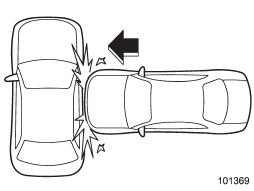
A severe side impact near the front seat activates the SRS side airbag.
Examples of the types of accidents in which the SRS curtain airbag will most likely deploy.
Legacy models
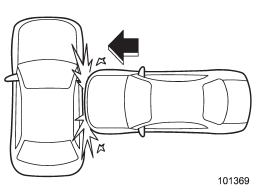
A severe side impact near the front seat or the rear seat activates the SRS curtain airbag.
Outback models
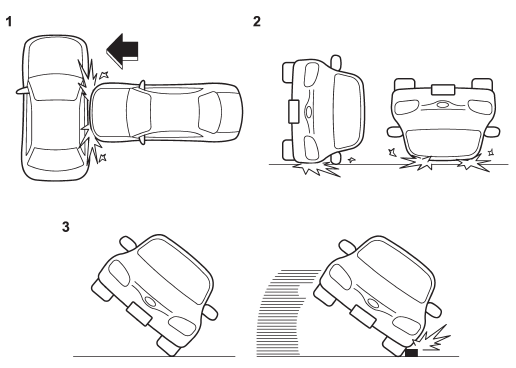
1) The vehicle is involved in a severe side impact near the front seat or the
rear seat.
2) The vehicle rolls onto its side or the roof.
3) The angle of vehicle tip-up is marginal or the skidding vehicle’s tires hit a
curbstone laterally.
Examples of the types of accidents in which it is possible that the SRS side airbag and the SRS curtain airbag will deploy (Outback).
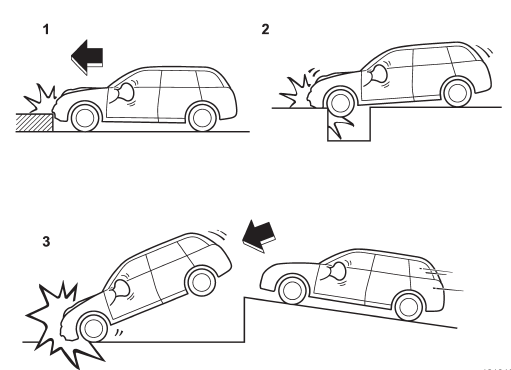
1) Hitting a curb, edge of pavement or hard surface
2) Falling into or jumping over a deep hole
3) Landing hard or vehicle falling
It is possible that the SRS side and curtain airbags will deploy if a serious impact occurs to the underside of your vehicle. Some examples are shown in the illustration.
Examples of the types of accidents in which the SRS side airbag is unlikely to deploy.
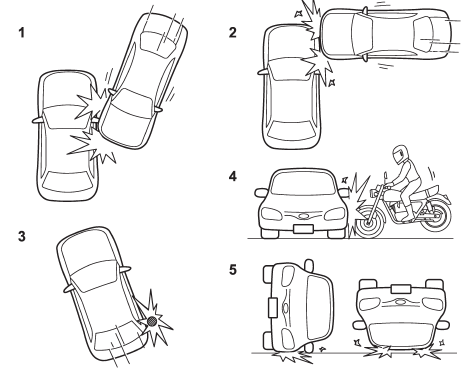
1) The vehicle is involved in an oblique side-on impact.
2) The vehicle is involved in a side-on impact in an area outside the vicinity of
the passenger compartment.
3) The vehicle strikes a telephone pole or similar object.
4) The vehicle is involved in a side-on impact from a motorcycle.
5) The vehicle rolls onto its side or the roof.
There are many types of collisions which might not necessarily require SRS side airbag deployment. In the event of accidents like those illustrated, the SRS side airbag may not deploy depending on the level of accident forces involved.
Examples of the types of accidents in which the SRS curtain airbag is unlikely to deploy.
Legacy models
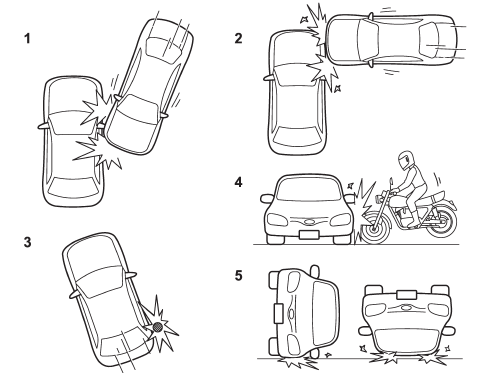
1) The vehicle is involved in an oblique side-on impact.
2) The vehicle is involved in a side-on impact in an area outside the vicinity of
the passenger compartment.
3) The vehicle strikes a telephone pole or similar object.
4) The vehicle is involved in a side-on impact from a motorcycle.
5) The vehicle rolls onto its side or the roof. There are many types of collisions
which might not necessarily require SRS curtain airbag deployment. In the event
of accidents like those illustrated, the SRS curtain airbag may not deploy depending
on the level of accident forces involved.
Outback models
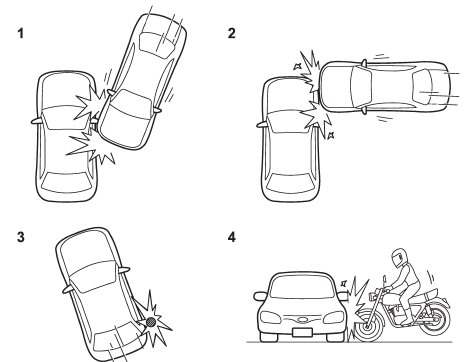
1) The vehicle is involved in an oblique side-on impact.
2) The vehicle is involved in a side-on impact in an area outside the vicinity of
the passenger compartment.
3) The vehicle strikes a telephone pole or similar object.
4) The vehicle is involved in a side-on impact from a motorcycle.
There are many types of collisions which might not necessarily require SRS curtain airbag deployment. In the event of accidents like those illustrated, the SRS curtain airbag may not deploy depending on the level of accident forces involved.
Examples of the types of accidents in which the SRS side airbag and SRS curtain airbag will basically not deploy.
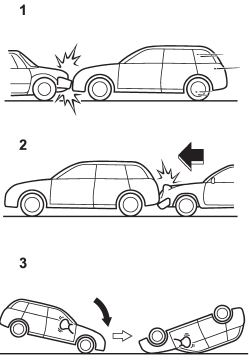
1) The vehicle is involved in frontal collision with another vehicle (moving
or stationary).
2) The vehicle is struck from behind.
3) The vehicle pitches end over end.
In the event of accidents like those illustrated, the SRS side airbag and SRS curtain airbag are basically not designed to deploy.
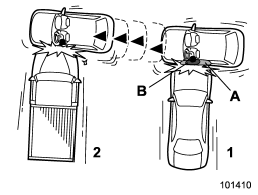
1) First impact
2) Second impact
A) SRS curtain airbag
B) SRS side airbag
In an accident where the vehicle is struck from the side more than once, the SRS side airbag and SRS curtain airbag deploy only once on the first impact.
Example: In the case of a double side impact collision, first with one vehicle and immediately followed by another from the same direction, once the SRS side airbag and SRS curtain airbag are activated on the first impact, they will not be activated on the second.
SRS airbag system monitors
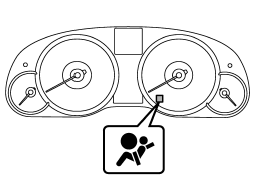
A diagnostic system continually monitors the readiness of the SRS airbag system (including front seatbelt pretensioners) while the vehicle is being driven. The SRS airbag system warning light will show normal system operation by illuminating for approximately 6 seconds when the ignition switch is turned to the “ON” position.
The following components are monitored by the indicator.
● Front sub sensor (right-hand side)
● Front sub sensor (left-hand side)
● Airbag control module (including impact sensors [all models] and rollover sensors
[Outback])
● Frontal airbag module (driver’s side)
● Frontal airbag module (front passenger’s side)
● Center pillar impact sensor (right-hand side)
● Center pillar impact sensor (left-hand side)
● Front door impact sensor (right-hand side)
● Front door impact sensor (left-hand side)
● Side airbag module (driver’s side)
● Side airbag module (front passenger’s side)
● Rear wheel house impact sensor (righthand side)
● Rear wheel house impact sensor (lefthand side)
● Curtain airbag module (right-hand side)
● Curtain airbag module (left-hand side)
● Seatbelt pretensioner (driver’s side)
● Seatbelt pretensioner (front passenger’s side)
● Seatbelt buckle switch (front passenger’s side)
● Front passenger’s occupant detection system weight sensor
● Front passenger’s occupant detection control module
● Front passenger’s frontal airbag ON and OFF indicator
● All related wiring
WARNING
If the warning light exhibits any of the following conditions, there may be a malfunction in the seatbelt pretensioners and/or SRS airbag system. Immediately take your vehicle to your nearest SUBARU dealer to have the system checked. Unless checked and properly repaired, the seatbelt pretensioners and/or SRS airbags will operate improperly (e.g. SRS airbags may inflate in a very minor collision or not inflate in a severe collision), which may increase the risk of injury.
● Flashing or flickering of the warning light
● No illumination of the warning light when the ignition switch is first turned to the “ON” position
● Continuous illumination of the warning light
● Illumination of the warning light while driving
SRS airbag system servicing
WARNING
● When discarding an airbag module or scrapping the entire vehicle damaged by a collision, consult your SUBARU dealer.
● The SRS airbag has no userserviceable parts. Do not use electrical test equipment on any circuit related to the SRS airbag system. For required servicing of the SRS airbag, consult your nearest SUBARU dealer. Tampering with or disconnecting the system’s wiring could result in accidental inflation of the SRS airbag or could make the system inoperative, which may result in serious injury.
CAUTION
If you need service or repair in areas indicated in the following list, have the work performed by an authorized SUBARU dealer. The SRS airbag control module, impact sensors and airbag modules are stored in these areas.
● Under the center console
● Inside each front fender
● Steering wheel and column and nearby areas
● Top of the dashboard on front passenger’s side and nearby areas
● Each front seat and nearby area
● Inside each center pillar
● Inside each front door
● In each roof side (from the front pillar to a point over the rear seat)
● Between the rear seat cushion and rear wheel house on each side
● Under the rear center seat
In the event that the SRS airbag is deployed, replacement of the system should be performed only by an authorized SUBARU dealer. When the components of the SRS airbag system are replaced, use only genuine SUBARU parts
NOTE
In the following cases, contact your SUBARU dealer as soon as possible.
● The front part of the vehicle was involved in an accident in which only the
driver’s SRS frontal airbag or both driver’s and front passenger’s SRS frontal airbags
did not deploy.
● The pad of the steering wheel, the cover over the front passenger’s SRS frontal
airbag, or either roof side (from the front pillar to a point over the rear seat)
is scratched, cracked, or otherwise damaged.
● The center pillar, front door, rear wheel house or rear sub frame, or an area
near these parts, was involved in an accident in which the SRS side airbag and SRS
curtain airbag did not deploy.
● The fabric or leather of either front seatback is cut, frayed, or otherwise damaged.
● The rear part of the vehicle was involved in an accident.
Precautions against vehicle modification
WARNING
To avoid accidental activation of the system or rendering the system inoperative, which may result in serious injury, no modifications should be made to any components or wiring of the SRS airbag system.
This includes the following modifications.
● Installation of custom steering wheels
● Attachment of additional trim materials to the dashboard
● Installation of custom seats
● Replacement of seat fabric or leather
● Installation of additional fabric or leather on the front seat
● Attachment of a hands-free microphone or any other accessory to a front pillar,
a center pillar, a rear pillar, the windshield, a side window, an assist grip, or
any other cabin surface that would be near a deploying SRS curtain airbag
● Installation of additional electrical/ electronic equipment such as a mobile two-way
radio on or near the SRS airbag system components and/or wiring . Modifications
on or inside the front door panels for the purpose of a speaker replacement or sound
insulation
CAUTION
Do not perform any of the following modifications. Such modifications can interfere with proper operation of the SRS airbag system.
● Attachment of any equipment (bush bar, bullbar, winches, snow plow, skid/sump
plate, etc.) other than genuine SUBARU accessory parts.
● Modification of the suspension system or front end structure.
● Installation of a tire of different size and construction from the tires specified
on the vehicle placard attached to the driver’s door pillar or specified for individual
vehicle models in this Owner’s Manual.
● Attachment of any equipment (side steps or side sill protectors, etc.) other than
genuine SUBARU accessory parts to the side body.
Always consult your SUBARU dealer if you want to install any accessory parts on your vehicle.


